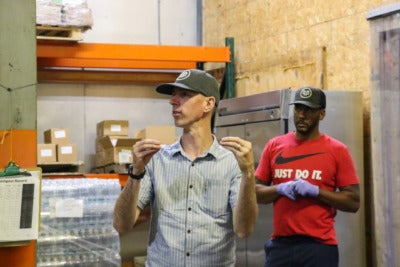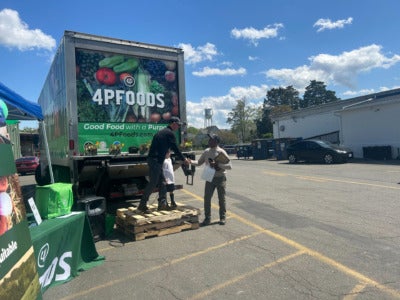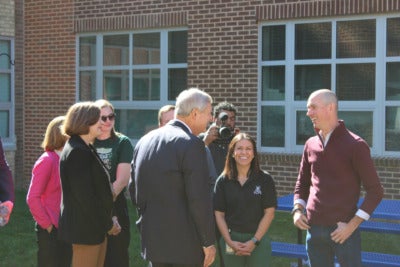The US food production industry is an impressively vast and complicated system, but not one that’s respectful of the people who produce and consume the food. Labor practices are notoriously exploitative, environmental degradation is rampant, and small producers are excluded from profitable markets—all to deliver food that isn’t particularly nutritious.
 But there is a better way, according to Tom McDougall. He’s the founder and CEO of 4P Foods—and an Aspen Institute Food Leaders Fellow. 4P Foods connects communities in the Mid-Atlantic region to more than 200 farmers, helping to return the food industry to a model that’s more nourishing for workers, producers, and consumers.
But there is a better way, according to Tom McDougall. He’s the founder and CEO of 4P Foods—and an Aspen Institute Food Leaders Fellow. 4P Foods connects communities in the Mid-Atlantic region to more than 200 farmers, helping to return the food industry to a model that’s more nourishing for workers, producers, and consumers.
The big goal at 4P Foods is to rebuild a regional, regenerative, and equitable food system. They work with local farmers so that food is delivered fresh, provide access to communities who are traditionally excluded from access to healthy food, and deliver to food hubs from subsidized food pantries to elite university dining halls. It’s a system explicitly designed to reduce inequities in agriculture and food access—and one that’s already paying off. In the current industrial food system, only 15 cents of a consumer’s dollar go to the food producer; if that same dollar is spent with 4P Foods, 65 cents make it back to the farmer. (These and other statistics are available in 4P Foods’ impact report.)
In the past 10 years, 4P Foods has proven that their model is scalable. The company is helping food producers build generational wealth, assisting socially disadvantaged farmers to access markets, and bringing food insecure communities fresh, healthy, planet-friendly food. To explain how it happens—and how it all got started—McDougall gave us a peek into what one idealistic food entrepreneur has done with his seed money.
Q: What led you to this work?
A: Growing up in the Hudson Valley region of New York, I saw a lot of the family farms around my community fail, get sold off, and turn into developments. When I moved to Washington, DC 20 years ago, I began to volunteer for food access and food justice organizations, and there I started to understand the other side of our broken food system. That was when I started to see it in terms of who has equitable access to good and healthy food that nourishes both our bodies and our planet—and who doesn’t, and why that is.
After some formative experiences in China and elsewhere early in my career, it started to become clear to me that the price we assign to things almost never represents the real cost. I didn’t have the words for “externalities” or “True Cost Accounting,” but I really wanted to spend my energy trying to help advance a better food system. You put some of those and other life experiences I had into a pot, stir it up, and I got spit out the other side as a social and environmental activist stuck inside an entrepreneur’s body. We launched 4P Foods 10 years ago to see if we can build a better food system together with a network of partners.
Q: From a food production perspective, what are the problems facing the US food system?
A: Many of the problems that the US food system faces are the byproduct of its architectural design, dating back roughly 400 years. We can see fairly clearly that the food system has been built upon a model that allows for and rewards externalities. If we start with land theft or the extraction of value by way of the enslavement of people, we can see a food system that’s been built on extraction and oppression which hasn’t really changed. If we fast forward a bit and into more recent history, we see a food system that, from the early 1970s, was really incentivized to “get big or get out,” largely in the name of efficiency, which may have been well-intentioned. That said, there has been a rippling of unintended consequences, including the struggle—and often the closure—of small and mid-sized family farms and the local and regional food systems that depended on those farms as their backbone.
Along the way, we had the centralization of other functions of the food system, including the centralization of processing, aggregation, and distribution that has reached a point where seven of the 10 lowest-paying jobs in our country are in the food supply chain. More than 60 percent of the fruits and vegetables that we consume in this country come from one valley in California. On the other end of the supply chain, our hunger and obesity crises are intertwined with this type of production-in-the-name-of-efficiency model. Our current food production system is one where the price of food does not represent the real costs: the cost of environmental degradation, the cost of nutrition insecurity for 40-plus million Americans, the cost of labor oppression, the cost of healthcare for diet-related illness, and so on. Unless and until we begin to properly assign those costs to the price of our food, we will forever incentivize a method of production that is simultaneously killing our planet and the sentient beings that depend on it.

Q: What’s unique about the 4P Foods approach?
A: As a public benefit corporation—which is to say a mission-driven company—our mission is one of duality. First, we exist to build a new food system that enables small and midsize regional farmers to not just survive but truly thrive. Second, as we do that, we work alongside partners to build an equitable food system so that everybody, regardless of income, race, age, or zip code, has a truly dignified and culturally appropriate experience in terms of choosing and consuming food that nourishes them in their communities. In other words, Purpose-fueled food for the Prosperity of People and Planet (the 4Ps). While that mission has been what has driven us for the past ten years, as you might imagine, it’s very hard to make that mission look good on a P&L… because how do you do that? How DO you pay farmers what they deserve for producing nutrient-dense food, for sequestering and storing carbon in soils, for increasing biodiversity, for storing and retaining water, for driving rural economies, and for feeding their communities, while ALSO serving that same food to everyone, including and especially those in historically marginalized communities at price points that work for them? Especially since these price points are, 10 times out of 10, less than what you just paid that farmer. And therein lies the gap—the space between the price that we should be paying farms for good healthy food and the price that all consumers can afford. That difference is part of what drives food deserts, and it’s why food apartheid is real, and it’s why we need a new system. That is what 4P Foods has been working on for the past 10 years, and that is what’s unique: We are taking a systemic approach to supporting our farms and creating equitable access to it for everyone.
Q: What results are you seeing so far?
A: For 10 years now, we have been building trust with our farmers, with our network of community-based organizations and partners, with a growing customer base that includes public school systems, universities, and corporate campuses, and with innovative healthcare providers who are piloting and scaling food-is-medicine interventions sourced from a values-based supply chain. As each one of those steps and series of partnerships has evolved, we see the thesis of food systems change coming to life. We see the economy moving towards and favoring local and regional food systems and food producers. We see an ever-growing awareness of the power of food as medicine, which is indigenous wisdom that communities the world over have known for thousands of years. And we see community-driven power in giving choice and dignity to historically oppressed communities and families as it relates to food sovereignty.
What this translates to is millions of dollars a year flowing to small and midsize farmers. And many more millions of dollars are flowing to consumers of all walks of life in the greater mid-Atlantic region. It gives us great hope.

Q: 4P Foods partners with farmers who are committed to low-impact, sustainable, and regenerative food production. How do you choose which farmers to partner with?
A: For us, it’s very important to meet farmers where they are in their journey. Especially in the case of small farmers and historically marginalized farmers, they may not have had the resources or tools to get, say, a certified organic label, or to partner up with the Savory Institute, or other great certifications that are important but at times out of reach. We try to connect with farmers where they are in terms of their growing practices so long as they are willing to commit to us to advance towards not just sustainable, but regenerative production practices that can heal the planet, create nutrient dense food, and develop resiliency in the supply chain.
Doing that involves bringing technical assistance and other resources to these farmers to help them move along that path, which is where the systems approach is critically important to our theory of change. A critical piece of the puzzle is bringing not only market channels to our farmer partners, but also the funding, the support, and the tools they need to lean into regenerative food production.
Q: What does a typical workweek look like for you?
A: The phrase “controlled chaos” comes to mind. It’s a small miracle all that our incredible team of people brings to life every single day. Early in the week we are receiving food into one of our warehouses from hundreds of different small food producers ranging from produce to meat to various dairies and value-added items. That food is then packed up into bags and boxes onto pallets into totes and put onto our trucks and delivered into one of three distinct lines of business.
We have a direct-to-consumer model that drops off farm-fresh groceries at people’s front doors. We have a wholesale model that delivers to restaurants, grocery stores, public school systems, institutions, catering companies, and other outlets. And we have a growing food as medicine and food access channel that partners with food banks, food pantries, low-income health clinics, hospitals, and others to deliver interventions like fruit and vegetable prescription programs to food-insecure families around the region. All of that takes an army of dedicated, wonderful people to ensure that that food gets where it needs to get when it needs to get there.
Q: You’ve recently completed your time as an Aspen Institute Food Leader Fellow. How did that experience shape your work and your mission?
A: This fellowship was, by far, the best opportunity I’ve ever had professionally, and was profound in ways I’m still learning to articulate for my own personal journey. It was a gift in so many ways, including providing the space and container to reorient our strategy for 4P Foods around a systems-based approach. Perhaps more importantly, it helped reassure me that we are on the right path. The idea of building a new food system that centers Mother Earth and builds equity is, in fact, my life’s work. Despite how hard it may feel at times, the fellowship really reminded me that it’s okay to pursue really hard things. I will be eternally grateful for the experience and look forward to sharing those blessings in any way that I can.
Q: What’s one thing you wish everyone knew about the food system?
A: As designed, our current food system is actively killing us and our planet. Yet with some changes to that design, there are over 600 million smallholder farms on the planet, each of which is supported by, on average, five people. That’s nearly 3 billion human beings actively engaged in small scale agriculture. To put it another way, nearly one third of our species is producing food. With the right incentive and architectural design of a new system, that army of people could adopt regenerative practices, ushering in a climate mitigation technology that Mother Earth has been developing for over 14 billion years, working with her systems as opposed to against. And in so doing, this movement has the power to usher in food sovereignty and economic prosperity for these farmers the world over, all while addressing the largest problem humanity has ever faced in the form of our rapidly warming planet. Our future food system is a place of tremendous hope—we just need to get to work bringing it to life.

